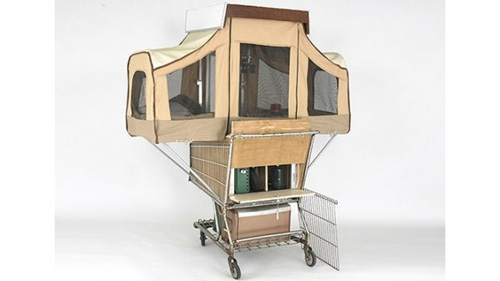
Silly as this looks, this is actually a thing.
*Nomadic Furniture*
By: gvi
10 January 2015

Silly as this looks, this is actually a thing.
Though there is no set time upon which the distinction is based, there is a difference subtle but discernable between staying in a tent and living in one. Like the judge's definition of obscenity, we know it when we see it.
I've stayed in tents and lived in tents in all climes and regions from poncho "hooches" in the subtropics and during the squalls preceding Hurricane Hugo, to lined and heated tents in the Korean winter, to any of several tent designs in America and the Middle East. I've also stayed in tents under decent conditions. Such episodes are few, and dimly remembered. Many Rubies have lived in tents far longer than I have, and their opinions carry a great deal of weight. But I think it's reasonable to say that it's not necessary to spend a whole year in a tent to consider one's tent-living dues card paid-up, or that such a long stay is necessary in order to see things which are observable in a shorter period of time.
My first time living in a tent, as opposed to merely staying in one, was during my first tour to Iraq. My Platoon stayed in what the permanent residents of the camp referred to as "circus tents." The tents were locally produced and quite large 60 Soldiers could stay comfortably in one, as long as everybody kept his area tidy and minded his own business. They had heat and air conditioning and, being canvas, were breathable and healthier than the smaller, more modern vinyl tents in the American supply system.
This was shortly before I became a Rubie; and while I was fairly comfortable in the tent being something of an old campaigner already by this time yet I was not nearly as comfortable as I could have been. Had we stayed there any longer than a month and a half, I and others would certainly have done something to improve our accommodations. We stayed in American-made tents (which were more modern, if not more comfortable) on my second tour, and we weren't in them nearly so long. Our quarters could certainly have been made nicer, and would have had they been permanent. On my first tour I was a seasoned Soldier who knew a thing or two about traveling "light but right." By the second, I was a Rubie accustomed to finding ways to thrive where most people would be doing well merely to endure.
So it was that on my second tour, waiting to go "up-country," the seed for the notion of the present article was planted. It was fertilized if you'll pardon the now-overburdened metaphor by a Rubie posting a link to a suite of cleverly-designed furniture going by the name of Casulo. It's worth a visit to the site.
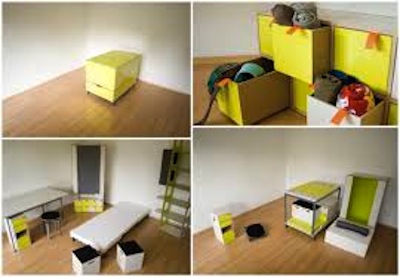
I suspect the International Space Station is homier
The Casulo set is "cleverly-designed" to the extent that watching it go from a box on a pallet to a studio's worth of furniture in ten minutes without tools or wasted materials is clever. It is not, however, something you'd want to live with (what do you expect it was designed by Germans). The "chair" is an unpadded piano stool and the "bed" a more generous name than it deserves looks so uncomfortable a ten-year old housecat wouldn't lie there with a sunbeam shining directly on it.
More recently, another Rubie posted a link to a company making bespoke furniture for the absurdly tiny apartments common to New York City. Again, more clever than comfortable, they require effort the average person is unwilling to put into his furniture. These include tasks like shoving beds back into nooks, folding up origami kitchen islands or collapsing map-fold closets. Most people would become exasperated rather quickly with having to constantly manipulate their surroundings thus.
But they are not without some merit, at least in terms of the questions they raise for Rubies thinking about the need for such a Spartan suite of furnishings. I could get all artsy-fartsy at this point, dropping phrases like "these installations deconstruct bourgeois assumptions of aesthetics and materialism and challenge the user to engage in meta-dialogue between mass and meaning in a post-consumptionist woof woof blah blah argle-bargle " You find lots of that kind of language in the articles written about this stuff. These articles, so it seems, are written to help hip, urban liberal-arts majors rationalize the fact that someone's convinced them to pay fat bank for spaces they'd protest over if prison inmates were put in them. But anyone who saw it in this article would know I was just poking snot-nosed fun at pretentious hipsters, which is about as sportsmanlike as hunting brood-sows with a scoped Barrett.
The questions worth posing include:
Our approach to the issue is more down-to-earth than it is an exploration of design-as-social-statement. For example, why would we need such a set of furniture at all? A couple of Rubies (you know who you are) honored me by providing the answers: We live in our homes normally with normal furniture, and our normal lives are reflected by the choice, amount and arrangement of it. But circumstances may require additional people staying in our homes. They might be team members, adult children or college-age kids coming to a place they know is safe, or an itinerant Rubie whom misfortune has overtaken. While it's prudent to allocate the space for these anticipated extra souls, should they show up, keeping furniture and space permanently set aside for them is just dumb.
Since these Rubies were kind enough to share their examples with me, I'd feel as though I was cheating them by not pursuing the matter.
What's the minimum amount of furniture necessary to function in the intermediate- to long-term with a degree of normalcy?
In answering this first question, the average person might take a look around his home and reply "Why, this much of course!" Experienced backpackers especially those hardy souls who thru-hike the Appalachian Trail may respond to the effect that they can fit everything they need on their backs.
The truth is somewhere in the middle. The two key words are "minimal" and "normalcy." The first person was me about midway through my first tour when I realized that, while I had a two-bedroom apartment full of stuff back stateside, my "worldly possessions" in a very real sense consisted only of what I could lay my hands on in eastern Iraq. The stuff back home may as well be on the moon for all the access I had to it. And the possessions in my immediate area could fit into two duffel bags, a backpack and a footlocker. On my second tour, I brought even less. Granted, my shelter and my bed were provided but that was it. The second person may well thru-hike the AT with Grandma Gatewood's laundry bag, but even the long duration of thru-hikes cannot be considered "normal." At some point, the hiker goes home, and it is this latter environment we're considering.
At a minimum, our furniture must meet the following requirements:
The backpack minimalist may say that the ground fulfills all these functions. Few but hobos can adapt themselves to this long-term, and fewer do it willingly. Even the Bedouin has cushions, blankets and pillows. Besides, if the ground is so damned good, why did anyone ever invent furniture in the first place?
There are plenty of ways to crack this nut, but my "minimum" consists of a folding cot of the military pattern, a camp chair of the common style and a black plastic locking footlocker with a padlock. We can of course get as fancy with these three minima as we wish. The Brits showed the world just how stylishly one can live outdoors with the Campaign Furniture designs of the 19th and early 20th centuries, which tends to be as expensive as it is both smartly utilitarian and breathtakingly gorgeous. Since few Rubies are independently wealthy, the three simple items I listed, and others to follow, recommend themselves more to our ends.
A military cot is the best in the line of temporary sleeping arrangements for several reasons:
There is really little to say against the military folding cot, except perhaps when one is accustomed to sleeping with company in his bed. I am not and haven't been since George W. Bush's first term as President, so my answers are for myself and those in like condition.
* A sleeping pad or mat for the cot is essential. The nylon surface of a cot is utterly unforgiving to bones and joints. Worse, they are remorseless thermal thieves, worse perhaps than bare ground for insulation. This article will leave unanswered the question of which pad or mat to use, as well as that of whether it should be kept as part of the furniture (like the Casulo's "mattress") or if it may be assumed the traveler will bring his own. My own opinion is that something ought to be put up with it, on the reasoning that one unneeded mat should the user bring his own is preferable to none at all if he didn't or was unable to.
We come next to the place to sit
Anyone who's ever spent time around cots knows that while they're great for sleeping, they're worthless for sitting or reclining. The common camp chairs you can get anywhere nowadays have the advantage of light weight, low cost, reasonable comfort and near universal availability. The only complaint against these cheap camp chairs is that it's difficult to sit up straight in them. They're made for relaxing, not work. Director's chairs or the folding chairs common to church fellowship halls are better for work but don't knock down as compactly.
When I go afield for short periods and know I can only take a backpack's worth of impedimenta, I find that the inclusion of a small folding three-legged stool is worth its weight and small bulk.
So we've got a place to sleep and a place to sit where do we put our stuff?
There are several varieties of footlockers available but the one whose praises I'm singing in this essay is the one commonly found in the PX and at many hardware or department stores for about $20.00 or so:
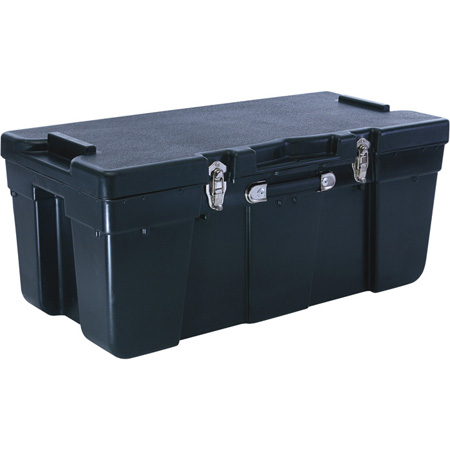
As mentioned before, it fits between the braces of a military cot; it's sturdy, will accept a padlock and it's very lightweight relative to the amount of stuff that can be kept in it. This last feature is important. I can attest from the personal experience of seeing Soldiers mail their extra effects home in these simple plastic containers that they will safely contain far more than the 70 pounds given as the maximum allowable weight for worldwide postal shipment. They're VERY sturdy. And when you stack them, they lock together like Lego blocks. Their tops are good work surfaces, though I don't recommend running a camp stove on them. Set out from under the cot, they make a halfway-decent "coffee table" and answer the purpose of a nightstand quite well.
We should spend some more time on the business of the lock on a footlocker. There are plenty of different types of containers for personal belongings, some better than others. But not all of them lock; and for our purposes, I submit that there must be a way to lock this container, for reasons having nothing to do with fear of theft.
Displacement and transience is traumatic. Even when I was traveling from one post to another, on a schedule I was aware of, on a tour I volunteered for, it was stressful. The act of locking our duffel bags was our way of establishing a boundary, a sense of ourselves, our space and the validity of our claim to our own things. Duffel bags can easily be cut open with a knife or scissors, but the symbolic boundary of a lock was universally respected. How vulnerable might one feel if he knew he had no way of keeping others out of his stuff? Even if no one had the slightest intention of going through his effects, it's still a powerful feeling of helplessness. It would be like someone obliged to walk around in his or her underwear all day even if no one took the least notice, the person would still feel exposed and vulnerable.
One of the purposes of preparedness is the elimination of unnecessary stressors. Locks are cheap. If the simple provision of a lock alleviates one stressor and contributes to a sense of boundaries, security and normalcy, where's the harm in it?
What can we do to maximize comfort and normalcy?
Moving up from these three items gives us an opportunity to move up from creating the illusion of normalcy and comfort to beginning to sustain it in fact.
Having spent enough time in barracks and semi-permanent tents to know what's worth having and what's not, I now consider a small floor rug at the side of the cot to be nearly mandatory. It's impossible to quantify, but this small addition adds materially to one's comfort and sense of civility in austere surroundings. When I carry just the stool in the backpack as noted above, a small welcome-mat sized rug gets rolled up and strapped to the pack. I think they're that important. They cost less than $10 at the Dollar Store.
On my first tour in Iraq I had one of these in the trailer I and four of my squaddies called "The Group Home:"
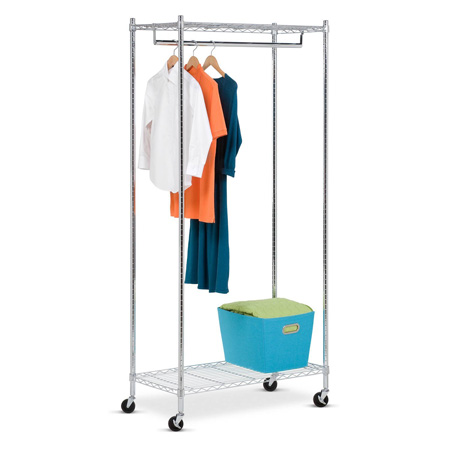
I ordered it and had it shipped to me. This took forever but it was a welcome addition. I also ordered a canvas cover to go over it. It tied in front and kept dust out. It made the garment rack look less like a garment rack and more like a proper military wall-locker. I also purchased a fabric-and-fiberboard set of hanging shelves in which I kept small articles like my undergarments, hygiene kit, hats/gloves and so forth.
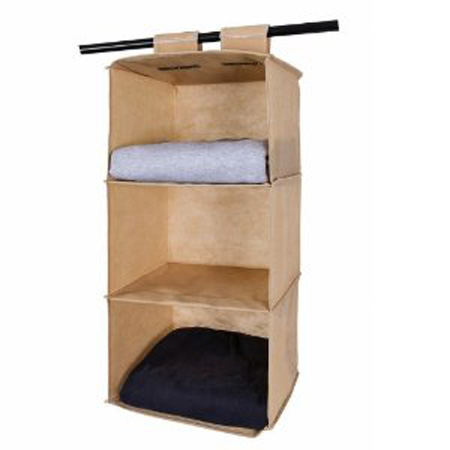
Beyond this, we start getting into the realm of personal preference, things that would be nice to have but aren't "mission-critical." For example, I happen to think a wastebasket is important, whereas others might be content with a plastic grocery bag hanging at a cot corner. I might add a battery-powered LED tabletop lantern whereas others may think it's unnecessary. I might want one of those collapsible file-folder boxes for papers (just thinking like a G.I. here), but it may be pointless for someone else. Our additional items ought to fit in the footlocker when the entire suite is stowed and, most importantly, not have to stay IN the footlocker once everything is set up after all, the footlocker is for things we'd be bringing with us. I'd certainly leave a lock and keys for the footlocker inside it, not expecting any guests (or myself if I were to stage this at a retreat) to have brought one.
There is an option to substitute for the wardrobe, which I only just ordered and received. As such, I haven't yet used it in the field, but I have set it up to assess it and its capabilities. The outfitter Cabela's offers a clothing rack called a "cot tree" which attaches to the end of a standard cot. It is little more than two telescoping uprights which attach to the ends, and a cross-member at the top. The bottom is secured either by straps or as one of the reviewers suggested two U-bolts.
Online reviews are mixed. I find it a solution with great potential but also with compromises. I bought two of these things, with the intention of using one at each end of the cot or should the need arise putting one with each of the two cots I own. This has the advantage of allowing the user to hang more stuff up and balance the weight better there is a risk of the thing tipping over if too much is placed on it without a counterweight at the other end. It also allows the user to suspend mosquito netting or fashion a privacy canopy.
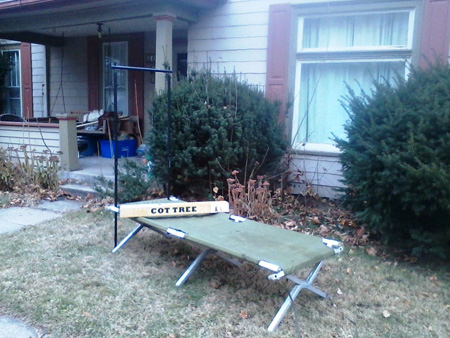
The second one is still in its box. This setup is temporary and done only for two reasons:
1) To show what it looks like and
2) To show that I actually DID buy the things!
Unlike the wardrobe I mentioned above, your clothing is in plain view. But this, I think, is a reasonable compromise in light of its advantages in utility, collapsed size (everything will easily strap to the cot) and cost. The cost of the two "cot trees" at the time of writing is $40.00, whereas the wardrobe with cover is proud of $70.
And what the heck you could make something very like these things with furring strips, shower curtain rods and common hardware. It's a solution that sort of recommends itself. I mention both the cot tree and wardrobe to illustrate what I have done in the past, as well as what I think might make the most sense in the present context. Taking all-in-all, I'm inclined to prefer the cot tree presently.
What compromises must be made in the name of minimizing this furniture's amount, size and cost?
As we've seen, we can begin to get carried away with what we include in this collection of furnishings. I could add field desks or portable drafting tables, the suitcase-on-furniture-legs where I keep my Field-Day ham radios, perhaps some variety of the Boy Scout "Chuck Box" for kitchen items and so on.
It's important in the sense of this essay to keep the ultimate purpose in mind; namely, accommodations for someone who is displaced. A cot, a chair and a footlocker is the minimum, with things like wardrobes, cot trees and rugs being nice additions. If you're fitting up a hunting lodge or cabin for yourself, your family and/or a team, you have far more flexibility.
A good surplus cot runs on average between $60 and $100, depending on where you find it and whether it is bought new or used. Camp chairs are often found on sale for around $10 or so I bought four when they were being sold at my local supermarket for $7.00 apiece. My footlockers cost $20. In all, you're looking at a ballpark figure of $100 for this set, cheaper if you shop well.
The amount of floor space ideally allotted to a Soldier in an "open-bay" barracks is somewhere around 60 square feet, taking a single-bed, footlocker and wall-locker (or wall-mounted hanging rack and shelf) into account, plus extra room on the sides. Spend enough time in enough barracks and you'll see Soldiers crammed in much more compactly, but this quickly becomes unhealthy both physically and mentally. This figure of 60 square feet is only for planning on how much to allot when you look around your home or retreat layout of furniture is more art than science. But my own experience has shown that this figure represents about the smallest space a person can have before he begins to feel cramped and packed-in and starts to easily get sick.
Having laid this all out to see what we get, we ought to spend a moment considering what we give up. The first thing we give up when we're setting up such an ensemble is the notion that we're in the home and routine we were in before. Whether we're setting it up for ourselves after having been displaced or setting it up for "unexpected guests," things are obviously not what they used to be.
We'll be giving up our privacy; or depending on our home situation from "before," we'll be re-defining our boundaries with others we're unused to sharing them with. We'll be learning new routines, giving up old ones, living with less and, looking at it squarely, adding a whole laundry list of stressors to our lives. It's the rare human being who can face this with perfect equanimity and as I've said dozens of times, the most important preps are mental.
How small can this furniture be scrunched down for storage or transport?
About a year ago I ran across an online discussion centered on the nebulous term "sustainability." The one who initiated the conversation put forth the idea that humanity's continued occupancy of the planet would be far more "sustainable" if only everyone would just pare his or her belongings down to what could be contained in a box one meter to each side. The discussion which ensued did its best to sugar-coat the unavoidable truth that "sustainability" in this context is nearly synonymous with "self-denying misery." Likewise, the discussion acknowledged that it's not possible for everyone, without conceding the self-evident absurdity of the phrase "if only everyone would just "
Most of the urbanites in the discussion couldn't conceive of such monkish simplicity. Those of us with DD214s know better. This "cubic meter" business is in fact daily life for anyone who's deployed or gone overseas, or set sail on an ocean-going vessel at any time in recorded history. We spend 9 months to a year with rather less than a cubic meter's worth of stuff; and in the case of the Squids, far less. Our quarters, furniture, food service and vehicles are provided, but they also stay behind when we leave. Had it been worth my while to contribute to the discussion, the "sustainability" advocate might have been surprised to learn that the very model of living he proposes is the soldier's and sailor's lot from time immemorial. It was obvious this had never occurred to any of the people involved.
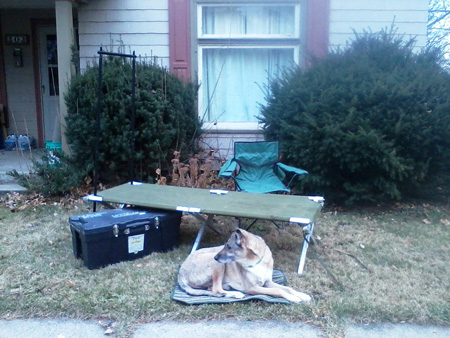
Hanging pockets not pictured because everyone knows what they look like
(Dog not included)
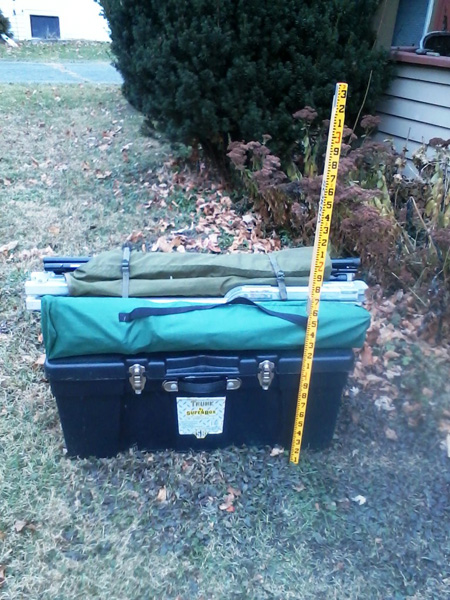
Folding level-rod for scale
Strapping the entire thing together with light-duty ratchet straps or if you're good at rigging lashing it all fast with 550 cord keeps the entire kit together, and prevents it from tumbling around. The 550 cord is a good idea for the cot tree if suspending a canopy is in your plans.
Summing up
An essential element to long-term "nomadic" living which we've only skirted is privacy. Everyone needs it, even if only for the time we're lying in bed. From the canopy arrangement I touched on, to the poncho partitions we fashioned in the "Group Home," to something as simple as sleeping masks and earplugs a necessity on a noisy flight line we all need something to shut the rest of the world out.
Neither have we addressed the question of who is to buy all this stuff. Like most things on the Rubicon, "it depends." If I'm a parent of a college-age kid, I'm likely to be the one buying it. College kids are nearly always broke; if they aren't, their parents ought to look seriously into the legality or morality of their finances. More importantly, young people consider themselves immortal, and don't tend to think about preparedness quite the same as those of us who have been to a funeral or five.
It's different if I'm staging things at a retreat, whether I own the property or whether I'm someone's guest. In this case, I as the user ought to be the one taking responsibility for my own accommodations it's only fair, after all. In the end, common sense and fair play ought to be the order of the day for how this stuff finds its way to us; then again, common sense and fair play ought to be the order of the day period.
Also not touched on are such topics as organization of space, allotment of responsibilities, hygiene, sanitation and all the other considerations of "nomadic" and communal living. It's an elephant sandwich, of which we've taken just one small bite. But "one bite at a time" is exactly how you eat an elephant sandwich. With luck, the rest of the Rubicon community can help us nosh down on the rest of the thing.
Related material: Preps in a Dormitory
gvi
www.alpharubicon.com
All materials at this site not otherwise credited are Copyright © 1996 - 2015 Trip Williams. All rights reserved. May be reproduced for personal use only. Use of any material contained herein is subject to stated terms or written permission.